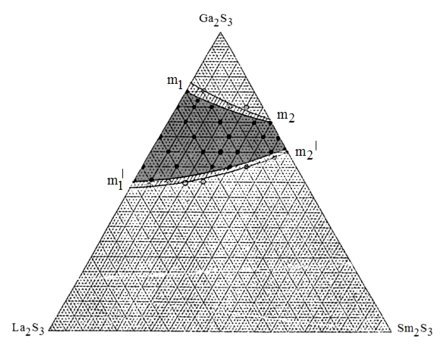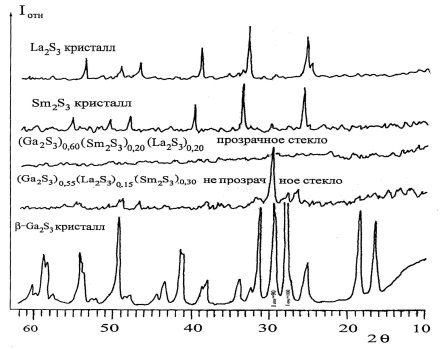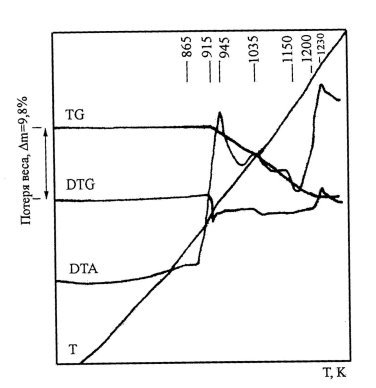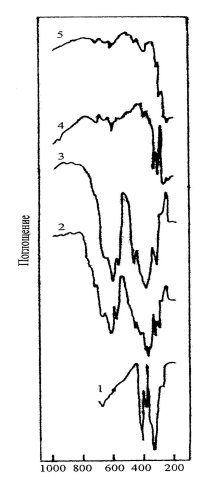The physical-chemical properties and thermal decomposition, as well as the IR spectrum of glass compositions (Ga2S3)0.60(La2S3)0.20(Sm2S3)0.20 and (Ga2S3)0.55(La2S3)0.15(Sm2S3)0.30 were examined. It was determined that the glass composition (Ga2S3)0.60(La2S3)0.20(Sm2S3)0.20 at 865 K is resistant to ambient oxygen. In the IR spectrum of the bands of glasses characterizing the Me-S bond, the intensity is increased and shifted to the high-frequency side of the spectrum in comparison with the initial crystal components, which is probably due to the increased covalence of the Me-S bonds.
Key words: physical-chemical properties, thermal decomposition, chalcogenides, lanthanides
Изучены физико-химические свойства и термическое разложение, а также ИК-спектры стекол составов (Ga2S3)0.60(La2S3)0.20(Sm2S3)0.20 и (Ga2S3)0.55(La2S3)0.15(Sm2S3)0.30. Установлено, что стекла состава (Ga2S3)0.60(La2S3)0.20(Sm2S3)0.20 при 865 К устойчивы к кислороду воздуха. В ИК-спектре у полос стекол, характеризующих связь Me–S, по сравнению с исходными кристаллическими компонентами увеличена интенсивность и смещена в высокочастотную сторону спектра, что вероятно обусловлено усилением ковалентности связей Me–S.
In recent years, there has been a great interest in the search for new materials, lanthanides, which could be used for optical devices. The glass-like base material is considered to have a minimum absorption coefficient within the range of wavelengths of interest. It’s compatibility with the waveguide fabrication process and for most applications with a low non-radiative increment of decrease of the excitation state solidness has a high rate of decay of the level density at radiation [1]. Among many alternatives, chalcogenide glass has become a serious rival for such ion-activated lanthanide of optical devices. Chalcogenide glasses provide a wide range of transparency ranging from 0.5 to 10 µm and a high refraction ratio (2.4) [2], low peak phonon energy 425 sm-1 [3] and high solubility allowing the introduction of high concentrations of lanthanides. They're thermally stable. In addition, compared with silicate, fluoride glass-like bases, chalcogenides achieved a significant improvement in quantum efficiency for lanthanide electronic transitions occurring from levels with a small energy gap to the adjacent underlying level. These properties make it possible to observe new lanthanide electronic transitions in the mid-infrared region of the spectrum, which cannot be observed in silicate and fluoride glasses, and open the possibility of creating effective amplifiers in the region of the second telecommunication window at a wavelength of 1.3 µm [4, 5].
Therefore, the aim of this work was to determine the probable boundary of the glass formation, as well as the study of some physical and chemical properties of the newly synthesized phases of the system under study.
Experimental part
In our experiments, -Ga2S3, -La2S3 и -Sm2S3 were used as initial components. -Ga2S3 is synthesized from elements crystallizing in the monoclinic system, similar to the literature data [2]. -La2S3 and -Sm2S3 are commercial reagents crystallizing in the rhombic system corresponding to the lattice parameters in [7].
Synthesis of the specimen from the region of glass formation consisting of these components was carried out under the pressure of sulfur vapor at 1425 K in a glass-graphite calcinatory placed in a quartz reactor [8]. The synthesis lasted for 2.5 h; subsequent hardening was carried out at a temperature of 1425 K by immersion in water of room temperature.
DTA of the samples were made using the derivatograph Q-1500D at the heating rate equal to 15˚/min. All the observed effects were endothermic, reversible. X-PhA were carried out using the diffractometer “Dron-2” in Cu-Kα emission with Ni-filter. The microhardness of the specimens was measured by PMT-3 hardness tester, and the optimal load of the specimen was 20 g. Microstructural analysis was carried out by MIM-7 microscope. The pycnometer method was used to determine the density of the specimen at a temperature of 300 K (filler — toluene).
IR absorption spectra of the initial components and glass samples were measured on the spectrometer «Spekord M80" in the area of 200–3000 sm-1 at 295 K. To record the spectra, the specimen was prepared in the form of paste on paraffinic oil; a window made of polymethylene and KBr was used.
Discussion of the outcomes
With the methods, physic-chemical analysis (DTA, DTG, XRA, MSA) were defined the boundary of the area of glass formation in the system La2S3–Ga2S3–Sm2S3 and specified its boundaries (Fig.1).
In the figure (m1m2 и m1'm2') the area of glass formation is limited in the system La2S3–Ga2S3–Sm2S3. Shaded area conforms to transparent stable glasses. The shaded strips in the figure correspond to opaque stable glasses and are explained by the presence of crystallization centers, which was confirmed by the XRA method (Fig. 2).
In triple glass in the area of rich La2S3, the stain of glass with an increased percentage of Sm2S3, darkens from yellow to ruby. The resulting glass is stable at room temperature in the air, in the water and in the organic solvents. Alkalis and acids partially break down them. With a slight heat completely dissolved in the sulfochromic mixture (bichrome).

Fig. 1. Dependence of the glass formation region on the composition in the system La2S3–Ga2S3–Sm2S3

Fig. 2. Diffractogram of alloys system La2S3–Ga2S3–Sm2S3
In view of isoctructurality La2S3 and Sm2S3, their diffraction pattern is almost the same (Fig. 2). However, diffraction effects Sm2S3 slightly displaced to the angle (2) of increase. On the diffraction pattern of alloys in the area of transparent glass formation, the diffraction effects of the alloy composition (Ga2S3)0.60(La2S3)0.20(Sm2S3)0.20 are not observed. Glass composition (Ga2S3)0.55(La2S3)0.15(Sm2S3)0.30 is not transparent, diffraction pattern which confirms the availability of crystallization centers.
Microhardness of glass composition (Ga2S3)0.60(La2S3)0.20(Sm2S3)0.20 equal to 600 MPa was studied.
The derivatographic analysis shows that during the thermal decomposition of the glass composition Ga2S3)0.60(La2S3)0.20(Sm2S3)0.20 in the air at 865 K, its softening occurs, which is accompanied by endoeffects. Observed at 915–1230 K, exoeffects and mass loss indicate a tendency of sequential oxidation of the glass.
Referring to the coincidence of the temperatures of crystallization and beginning of decomposition of the glass, exo-effects of crystallization was not determined. Thermolysis weight loss is 9.8 %.
As Figure 4 shows, the IR spectra of Sm2S3, La2S3 и Ga2S3, identical in the area of 220–360 sm-1, there are also intense bands related to the valence vibrations of the Me–S bonds, however, these bands appear in the Ga2S3 spectra at a higher frequency area of the spectrum (260–480 sm-1). In addition, the spectra of these sulfides show a number of weak bands in the area of 540–750 sm-1, which apparently also belong to the valence vibrations of Me–S. Note that these bands in the spectra of glasses obtained from the combinations of these sulfides become more intense, which, apparently, is due to the change in the covalence of the Me–S bonds. The spectra (Ga2S3)0.60(La2S3)0.20(Sm2S3)0.20 and (Ga2S3)0.60(Sm2S3)0.40 also have wide intense bands of 260–500 sm-1 with several maxima of 280 w., 320 str., 380 str. and 280 w., 295 med., 320 str., 360 pl., 385 s. 420 pl., 460 med., respectively. As can be seen, these bands are shifted to the high-frequency side of the spectrum in comparison with the spectra of individual sulfides, which is also probably due to the increase in covalence of Me-S bonds.
Thus, the boundaries of the area of glass formation in the system La2S3–Ga2S3–Sm2S3 were determined and the thermal decomposition and IR spectra of the obtained glasses were studied. It was established that the glass composition (Ga2S3)0.60(La2S3)0.20(Sm2S3)0.20 at 865 K is resistant to ambient oxygen. IR spectra of the obtained double and triple glasses are almost identical. In the glass bands characterizing the Me–S bond in comparison with the initial crystal components, the intensity is increased and shifted to the high frequency side of the spectrum, which is probably due to the increase in the covalence of the Me–S bonds.

Fig.3. Derivatogram of thermal decomposition of glass composition La2S3 — Ga2S3 — Sm2S3 in air

Fig.4. IR-spectrum of alloys of the system La2S3 — Ga2S3 — Sm2S3
References:
1. Oliveira A. S., De Aranjo M. T., Gouveia-Neto A. S. et al. //Frequency upconversion in Er3+/Yb3+ codoped chalcogenide glass, Applied Physics Letters. 1998. vol. 72. no7. pp.754
2. Kumta P. N., Risbud S. H. //J.Mater. Sci. 1994. vol.27. pp.1135.
3. Hewak D. W., Medeiros Neto J. A., Samson B. N. et al. / IEEE Photonics Technol. Lett. 1994. vol. 6. pp. 609.
4. Samson B. N., Medeiros Neto J. A., Laming R. J. et al. //Electron. Letta. 1994. vol.30. pp. 1617.
5. Medeiros Neto J. A., Taylor E. R., Samson B. N. et al. // J.Non-Cryst, Solid. 1995. vol. 184. pp. 293.
6. Goodyear I., Steigmann G. A. // Acta Cryst, 1963. vol. 16. no 10. pp. 946.
7. Kost ME, Shilov A. L., Mikheeva V. I. et al. Compounds of rare earth elements. Hydrides, borides, carbides, phosphides, pnictides, chalcogenides, pseudohalides. M.: Nauka, 1983. pp. 272.
8. (Кост М. Е., Шилов А. Л., Михеева В. И. и др. Соединения редкоземельных элементов. Гидриды, бориды, карбиды, фосфиды, пниктиды, халькогениды, псевдогалогениды. М.: Наука, 1983. 272 с.)
9. Bakhtiyarli İ. B., Kerimov O.Sh. //J. Chemical Problems 2003. no3, pp. 27.
10. Kertman, A.V., Optical sulfide ceramics, Soros. Obrazov. Zh., 2000, vol. 6, no. 2, pp. 93–98.
11. Minaev, V.S., Stekloobraznye poluprovodnikovye splavy (Glassy Semiconductor Alloys), Moscow: Metallurgiya, 1991.
12. Gregor, R.E., Optical micro-resonators in chalcogenide glass. Southampton: University of South ampton Faculty of Science, Engineering and Mathematics, 2009. http://eprints.soton.ac.uk.
13. Ivanova, T.Yu., Man’shina, A.A., Kurochkin, A.V. et al., Er3+ to glass matrix energy transfer in Ga–Ge–S:Er3+ system, J. Non-Cryst. Solids, 2002, vol. 298, pp. 7–14. doi.org/https://doi.org/ 10.1016/S0022–3093(01)01044–4
14. Bishop, S.G., Turnbull, D.A., and Aitken, B.G., Excitation of rare-earth emission in chalcogenide glasses by broadband Urbach edge absorption, J. Non-Cryst. Solids, 2000, vol. 266–269, pp. 876– 883. doi.org/. https://doi.org/10.1016/S0022–3093(99)00859–5.







